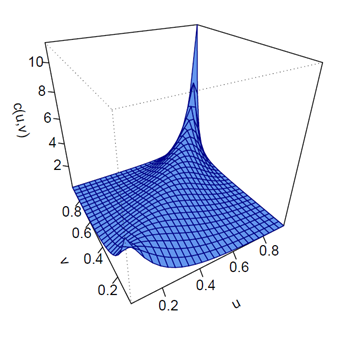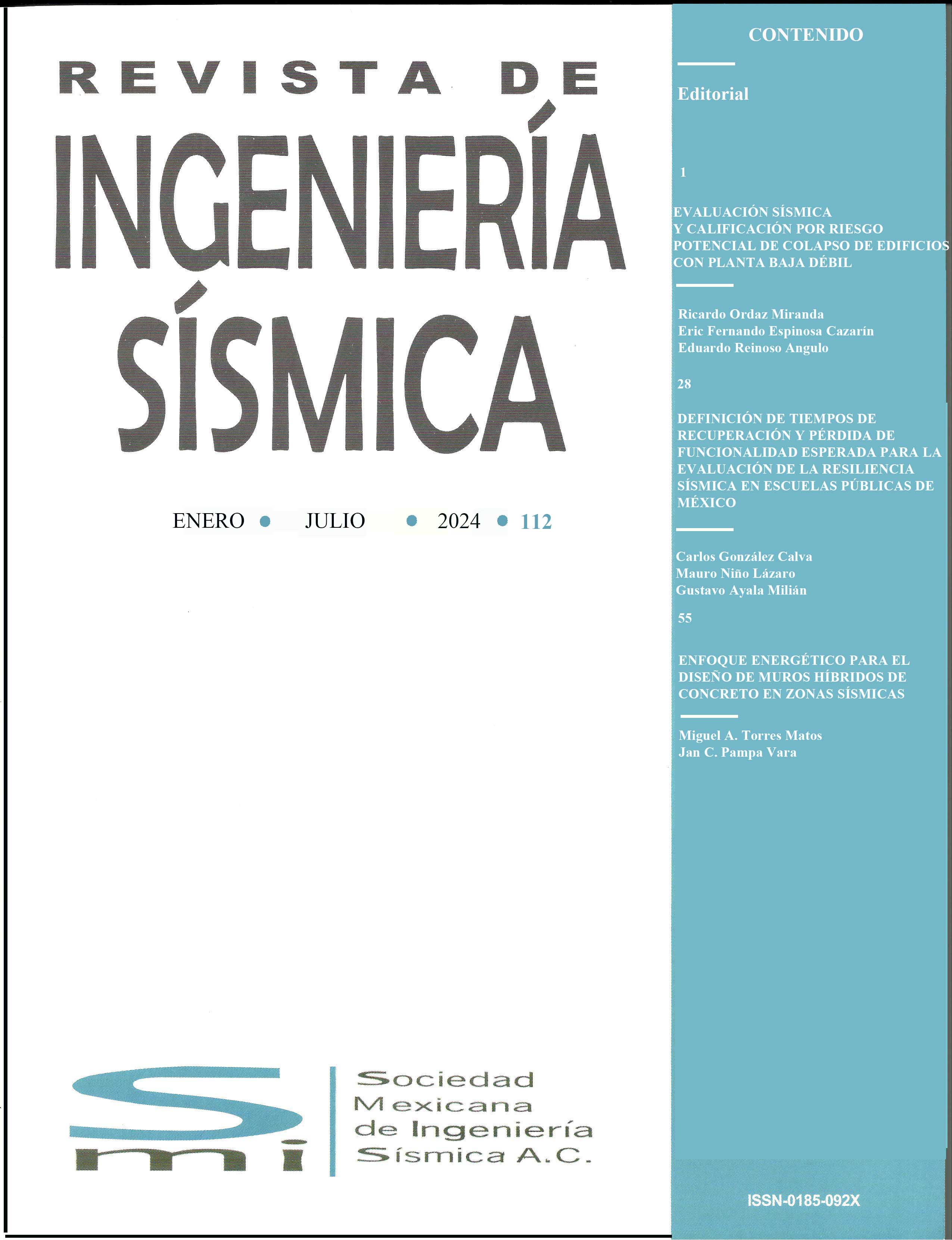MULTIVARIATE PROBABILISTIC ANALYSIS OF SEISMIC HAZARD USING COPULAS
DOI:
https://doi.org/10.18867/ris.107.588Keywords:
Seismic demand analysis, mean rate of exceedance, maximum interstory drift, spectral acceleration, vector-valued intensity measureAbstract
Multivariate probabilistic analysis of seismic hazard allows estimating the exceedance rate of vector-valued intensity measures of ground motion considering their joint probability distribution. Such an analysis is used for probabilistic seismic demand analysis of structures whose response is correlated with a set of intensity measures. In such cases, it is convenient to compute the exceedance rate of the response employing the exceedance rate of vector-valued intensity measures, in contrast to a univariate approach where the exceedance rates of a set of scalar intensity measures are calculated separately without accounting for their statistical dependence. In this work, a multivariate formulation is advanced for probabilistic seismic hazard analysis of vector-valued intensity measures using copulas. The formulation is generic considering that the exceedance rate is expressed in terms of the copula of a vector-valued intensity measure, without assuming a type of parametric model for its multivariate probability distribution. The proposed formulation is used in an example to assess the mean exceedance rate of the maximum interstory drift of a 20 story steel building employing a regression model in terms of the spectral accelerations for the first two structural periods. The copula model of the vector of spectral accelerations was estimated using ground motion records from stations on stratified sand and silt deposits in Mexico City. This type of seismic ground motion produces a significant contribution of the response associated with the second mode of the structure. The exceedance rates obtained from the multivariate formulation were significantly less than those from a univariate analysis using the spectral acceleration at the fundamental period of the structure as scalar intensity measure.
Downloads
References
Akaike, H (1973), “Information theory and an extension of the maximum likelihood principle”, In: Proceedings of the second international symposium on information theory, p. 267–81. https://doi.org/10.1007/978-1-4612-1694-0_15
Baker, J (2007), “Probabilistic structural response assessment using vector-valued intensity measures”, Earthquake Engineering and Structural Dynamics, 36, 1861-1883. https://doi.org/10.1002/eqe.700
Baker, J y C A Cornell (2005), “A vector-valued ground motion intensity measure consisting of spectral acceleration and epsilon”, Earthquake Engineering and Structural Dynamics, 34, 1193–1217. https://doi.org/10.1002/eqe.474
Baker, J W y N Jayaram (2008), “Correlation of spectral acceleration value from NGA ground motion models”, Earthquake Spectra, Volume 24, No. 1, 299-317. https://doi.org/10.1193/1.2857544
Barbosa, A R (2011), “Simplified vector-valued probabilistic seismic hazard analysis and probabilistic seismic demand analysis: application to the 13-th story NEHRP reinforced concrete frame-wall building design example”, Ph.D Dissertation, University of California, San Diego.
Bazzurro, P (1998), “Probabilistic seismic demand analysis”, Ph.D Dissertation, Stanford University.
Bazzurro, P y C A Cornell (2002), “Vector-Valued probabilistic seismic hazard analysis (VPSHA)”, Proceedings, 7th U. S. National Conference on Earthquake Engineering, Boston, USA.
Bazzurro, P, P Tothong y J Park (2009), “Efficient approach to vector-valued probabilistic seismic hazard analysis of multiple correlated ground motion parameters”, 10th Intl. Conf. on Structural Safety and Reliability (ICOSSAR09), Osaka, Japan.
CFE (2015), Manual de Obras Civiles. Diseño por Sismo, Comisión Federal de Electricidad. Instituto de Investigaciones Eléctricas.
Conte, J P y Y Zhang (2007), “Performance based earthquake engineering: application to an actual bridge-foundation-ground system”, 12th Italian National Conf. on Earthquake Engineering, Pisa, Italy.
Cornell, C A (1968), “Engineering seismic risk analysis”, Bull Seismol Soc Am, 1968, 58:1583–606. https://doi.org/10.1785/BSSA0580051583
Cornell, C A y E Vanmarcke (1969), “The mayor influences on seismic risk”, Proc., 4th WCEE, Santiago de Chile, vol. I, A-1, 69-83.
Embrechts, P, A J McNeil y D Straumann (2002), “Correlation and dependency in risk management: properties and pitfalls”, In: Dempster M, editor. Risk management: value at risk and beyond. Cambridge University Press; p. 176–223.
Esteva, L (1967), “Criteria for the construction of spectra for seismic design”, 3rd Panam. Symp. Struct., Caracas, Venezuela.
Faggella, M, A R Barbosa, J P Conte, E Spacone y J I Restrepo (2013), “Probabilistic seismic response analysis of a 3-D reinforced concrete building”, Structural Safety, 44, 11-27. https://doi.org/10.1016/j.strusafe.2013.04.002
Genest, C y A C Favre (2007), “Everything You Always Wanted to Know about Copula Modeling but Were Afraid to Ask”, Journal of Hydrologic Engineering, ASCE, 12:4, 347-368. https://doi.org/10.1061/(ASCE)1084-0699(2007)12:4(347)
Genest, C, B Rémillard y D Beaudoin (2009), “Goodness-of-fit tests for copulas: a review and a power study”, Insur: Math Econ. 44, 199–213. https://doi.org/10.1016/j.insmatheco.2007.10.005
Goda, K y S Tesfamariam (2015), “Multi-variate seismic demand modelling using copulas: Application to non-ductilite reinforced concrete frame in Victoria, Canada”, Structural Safety, 56, 39-51. https://doi.org/10.1016/j.strusafe.2015.05.004
Gupta, A y H Krawinkler (1999), Seismic demands for performance evaluation of steel moment resisting frame structures, Earthquake Engineering Center Blume, Department of civil and Environmental Engineering Stanford University, Report No.132.
Gutenberg, B y C F Richter (1944), “Frequency of earthquake in California”, Bull. Seism. Soc. Am., 46, 105-145.
Hofert, M, I Kojadinovic, M Maechler, J Yan, J Neslehova y R Morger (2020), “Multivariate dependence with copulas”, R package Copula, version 1.0-1. URL: http://copula.r-forge.r-project.org
Jayaram, N, J W Baker, H Okano, H Ishida, M W Jr McCann y Y Mihara (2011), “Correlation of response spectra values in Japanese ground motions”, Earthquake and Structures, 2(4), 357-376. https://doi.org/10.12989/eas.2011.2.4.357
Joyner, W B y D M Boore (1988), “Measurement, characterization, and prediction of strong ground motion”, Proceedings Earthquake Engineering and Soil Dynamics, II GT Div./ASCE, Park City, Utah, pp. 43-101.
Kohrangi, M, P Bazzurro y D Vamvatsikos (2016), “Vector and scalar IMs in structural response estimation, Part I: Hazard analysis”, Earthquake Spectra, 32, No. 3, 1507–1524. https://doi.org/10.1193/053115EQS080M
Lebrun, R y A Dutfoy (2009), “Do Rosenblatt and Nataf isoprobabilistic transformations really differ?”, Probab Eng Mech, 24:577–84. https://doi.org/10.1016/j.probengmech.2009.04.006
Luco, N y A Cornell (2007), “Structure-specific scalar intensity measures for near-source and ordinary earthquake ground motions”, Earthquake Spectra, 23, 357-392. https://doi.org/10.1193/1.2723158
Moehle, J y G Deierlein (2004), “A framework methodology for performance-based earthquake engineering”, 13th World Conf. on Earthquake Engineering, Vancouver, Canada, Paper No. 679.
Montes-Iturrizaga, R y E Heredia-Zavoni (2015), “Environmental contours using copulas”, Applied Ocean Research, 52, 125-139. https://doi.org/10.1016/j.apor.2015.05.007
Montes-Iturrizaga, R y E Heredia-Zavoni (2016), “Multivariate environmental contours using C-vine copulas”, Ocean Engineering, 118, 68-82. https://doi.org/10.1016/j.oceaneng.2016.03.011
Montes-Iturrizaga, R y E Heredia-Zavoni (2017), “Assessment of uncertainty in environmental contours due to parametric uncertainty in models of the dependence structure between metocean variables”, Applied Ocean Research, 64, 86-104. https://doi.org/10.1016/j.apor.2017.02.006
Nelsen, R B (2006), An introduction to copulas, 2nd ed. New York: Springer.
R Core Team (2020), “R: A language and environment for statistical computing”, R Foundation for Statistical Computing, Vienna, Austria. URL https://www.R-project.org/.
Rajeev, P, P Franchin y P E Pinto (2008), “Increased accuracy of vector-IM-based seismic risk assessment?”, Journal of Earthquake Engineering, 12(S1), 111-124. https://doi.org/10.1080/13632460801925798
Reyes, C, E Miranda, M Ordaz y R Meli (2002), “Estimación de espectros de aceleraciones correspondientes a diferentes periodos de retorno para las distintas zonas sísmicas de la Ciudad de México”, Revista de Ingeniería Sísmica, No. 66, 95-121. https://doi.org/10.18867/ris.66.198
Rosenblueth, E y A Arciniega (1992), “Response spectral ratios”, Earthquake Engineering and Structural Dynamics, Vol. 21, pp 483-492. https://doi.org/10.1002/eqe.4290210603
Salvadori, G, C De Michele, N T Kottegoda y R Rosso (2007), Extremes in nature. An Approach Using Copulas, Springer.
Schwarz, G (1978), “Estimating the dimension of a model”, Ann Statist, 6(2) :461–464. https://doi.org/10.1214/aos/1176344136
Shome, N (1999), “Probabilistic seismic demand analysis of nonlinear structures”, Ph.D Dissertation, Stanford University.
Shome, N y C A Cornell (1999), Probabilistic Seismic Demand Analysis of Nonlinear Structures, Report No. RMS-35, Department of civil and Environmental Engineering, Reliability of Marine Structures Program, Stanford University.
Sklar, A (1959), Fonctions de répartition à n dimensions et leurs marges, Publ. Inst. Stat. Univ. Paris, 8, 229–231.
Tang, X-S, D-Q Li, C-B Zhou y L-M Zhang. (2013a), “Bivariate distribution models using copulas for reliability analysis”, J Risk Reliab, 227(5):499–512. https://doi.org/10.1177/1748006X13481928
Tang, X-S, D-Q Li, C-B Zhou, K-K Phoon y L-M Zhang. (2013b), “Impact of copulas for modeling bivariate distributions on system reliability”, Struct Saf, 44:80–90. https://doi.org/10.1016/j.strusafe.2013.06.004






